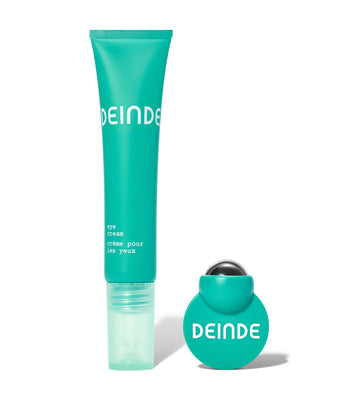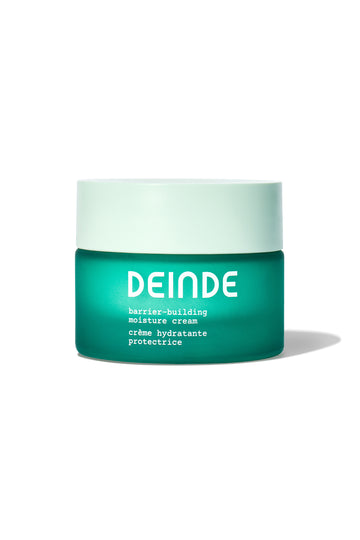
Treating Over-Exfoliated Skin
We have to talk about the big ex. The one that really gets under your skin; irritating and hitting your sensitive side. Let’s say it together: over-exfoliation.
On the surface, exfoliation can be great for your skin and complexion. Just like all good things, exfoliation should be done in moderation. But hey, we’re only human, and we’re bound to over-indulge every once in a while—especially when we start to see results with our skincare
If you’re starting to get a sinking feeling that maybe you’ve recently over-exfoliated, we’ve got you covered. Let’s dive into the science of exfoliation, over-exfoliation, and how to bounce back from the damage.
What To Know About Exfoliation
The epidermis, or outermost layer of our skin, isn’t just important because it’s the first thing people see. It directly faces the damaging impacts of external stressors more often than any other organ. It’s the epidermis that protects us from environmental factors, like UV rays and pollutants, and prevents moisture loss.
Part of the epidermis’s repair and renewal process is skin cell turnover, or the natural removal of dead skin cells. On average, our skin cells turnover every month, but the older we get, the longer it takes. In our 20s and 30s, the average rate is 28 days, growing to between 40 and 60 days in our 40s, and continuing to increase from there.
Exfoliation helps remove dead skin cells, and can stimulate cell turnover. Radiance, even when it comes to skin, is determined by light reflectance from the surface of smooth skin. A buildup of dead skin means poor light reflection, dimming radiance, and can create the illusion of large pores, and contributes to dry, or rough skin.
So when you exfoliate, you essentially restore your glow and radiance, as fresher cells and more even-looking skin emerge.
An exfoliation routine may also hold benefits like unclogging pores and reducing breakouts, stimulating collagen production, and helping to improve product absorption. As we get older, our skin tends to become less absorbent. Exfoliation can help all your favorite products do their job just that much better.
What Are the Main Types of Exfoliation?
There are two main types of exfoliation: physical and chemical. Physical exfoliation methods include products like scrubs or polishes. They may be formulated with grains, seeds, or ground nutshells and honestly, with this kind of recipe, we could pivot to making a great trail mix.
Chemical exfoliants depend on key active ingredients to do the work, like alpha-hydroxy acids (AHAs) and beta-hydroxy acids (BHAs). Glycolic acid and lactic acid both fall under the category of AHAs, while salicylic acid is the most common BHA. Chemical exfoliants work similarly to physical ones, using enzymes and acids to remove dead skin cells instead of grains.
Chemical peels are a more intensive procedure, and should always be entrusted to a professional. Meant to penetrate your skin at a deeper level, peels, just like other exfoliants, still work to “resurface” your skin. While chemical exfoliants can be used several times a week, chemical peels can be done every few months or even years, depending on the intensity of the treatment.
New to exfoliating? Start with just a washcloth and water to test your skin’s tolerance for mild physical exfoliation. Then, you can work up to lighter scrubs or gentle chemical exfoliants. Remember, always patch test on your arm or neck before using a new product on your face, in case of an unexpected reaction.
If you’re exfoliating, keep it to 2 or 3 times per week to preserve and protect your skin barrier.
What Is Over-Exfoliation?
So far, exfoliation seems like a good thing, right? And it definitely still is, but when you over-treat your skin, you can actually damage your skin barrier, or your epidermis. Over-exfoliation can lead to dehydrated skin, leaving it more fragile and vulnerable to the elements.
One of the skin’s biggest defensive functions is not just preventing water loss, but the loss of ions, serums, and proteins. A compromised skin barrier may become more prone to infections, allergens, and irritants, leading to dermatitis, aka skin inflammation.
What Are Some Common Signs of Over-Exfoliation?
- Dryness: Look for dry, flaky patches, or skin that feels tight, especially after cleansing.
- Itchiness: Dry, irritated skin may also feel itchy.
- Sensitivity: Your skin may be responding negatively to your regular products or environmental factors.
- Breakouts: Over-exfoliation can aggravate acne or trigger breakouts as dehydrated skin triggers oil production.
- Redness: Your skin might appear red or inflamed.
Damaged skin cells produce more melanin as a defense mechanism. Post-inflammation, you may find hyperpigmentation spots, or dark, dull-looking marks. Don’t worry, we’ll touch on some great solutions for treating hyperpigmentation, too.
What Can You Do If You Over-Exfoliated?
If you overdid it on the exfoliating products, the good news is, you’re in the right place. First, you’ll want to reduce the number of products you’re using.
Make sure to put down the exfoliator and any other harsh or dehydrating ingredients, including:
- Fragrances, synthetic or natural
- Alcohol, which can strip skin of natural oils
- Sodium Lauryl Sulfate, a cleansing and foaming agent
- Retinol / Tretinoin
- Benzoyl Peroxide, used to target acne
- AHAs and BHAs
- Propylene Glycol, a preservative
These types of ingredients can further irritate your skin. You should shift your focus to repairing and restoring the skin barrier which means incorporating humectants—ingredients that sink and seal in moisture.
What Ingredients Are Beneficial After Over-Exfoliation?
- Glycerin: As a humectant, glycerin is able to draw in and trap moisture, deeply hydrating and nourishing skin. You’ll want glycerin to be listed in the top 3 ingredients of your product. Look for it in moisturizers and cleansers.
- Hyaluronic Acid: Another humectant, hyaluronic acid can bind over 1,000 times its weight in water. It helps your skin attract and retain water, making it a great moisturizer. You can find hyaluronic acid on its own, and in creams, serums, and cleansers (like our moisture-locking face stick)
- Petrolatum: You know it. You love it. It’s simply petroleum jelly and it’s great in preventing moisture loss.
- Lipid Complexes & Ceramides: Ceramides are a type of lipid, or fatty acid, which play a big role in the structure and function of the epidermis, protecting your skin from dryness.
What Is a Good Over-Exfoliation Routine?
To treat over-exfoliated skin, we’re taking it back to the (hydrating) basics. Here’s a super simple skin care routine you could use to put your skin barrier first.
AM + PM
- Use a gentle, moisturizing cleanser with cool or lukewarm water. Our purifying whipped cleanser, a pH-friendly formula that is suitable for all skin types. This gentle cleanser washes away impurities and dirt while maintaining your skin barrier. It’s made with fermented vegetable-based glycolipids, which gently cleanse while supporting the microbiome. The active ingredient, Allantoin, is a softening and soothing skin conditioner. Plus, it’s fragrance-free.
- Once your skin is dry, apply a hyaluronic acid (HA) serum. HA may help your body produce more collagen and elastin, and is shown to be able to increase your skin’s hydration by 55%.
- Let the serum absorb, and layer on a moisturizer with lipids or ceramides. You may want to look for a more intensive moisturizer for your nighttime routine. Our moisture-locking face stick is a great, on-the-go solution to boost moisture and protect against damage. Plus, it’s made with squalane, a skin-identical lipid that binds moisture, and ceramide NP, another skin-identical lipid that locks in moisture and fortifies the skin barrier.
- (AM only) Add the SPF for sun protection! Look for a sunscreen that has the added power of hydrating ingredients like shea butter, or glycerin.
Struggling with hyperpigmentation? Once your skin has recovered, you may benefit from Vitamin C, Niacinamide, or slowly (emphasis on slowly) resuming chemical exfoliators like AHAs, to help lighten the look of dark spots. Vitamin C may be able to help block the production of melanin while Niacinamide is believed to work more closely like an exfoliator, supporting cell turnover.
DEINDE’s proprietary biotech active, Naringenin, is a superhero ingredient when it comes to skin barrier repair, supporting lipid synthesis and helping to seal in moisture. You can find it in our moisture-locking face stick and skin strengthening serum.
Talk to a Professional
At the end of the day, if you have concerns about extensive barrier damage, or are struggling with repair, it’s best to seek the advice of a dermatologist. They’ll be able to properly assess your condition and skin type to provide the most effective recommendations.
How To Perform Exfoliation Properly
When you, and your skin, are ready to exfoliate again, we’ve got a few tips to help you play it safe.
- Your skin type should play an active role in your exfoliation process. If your skin is sensitive, try a mild chemical exfoliator over a physical one. For oily skin, stronger treatments like physical exfoliation could be a better fit, but if you have a darker skin tone harsher treatments could result in hyperpigmentation.
Chemical exfoliants can offer a chance at more control over your exfoliation. With physical exfoliation, putting too much physical pressure you put on the skin can disrupt the skin barrier.
Flaky, dry skin or sensitive skin? It may be best to take a pause on exfoliation and continue to make hydration the priority.
-
What skin care products are you using already? Make sure to take into account any medications and products with aggressive ingredients like retinol or benzoyl peroxide as they can exacerbate sensitivity and dry skin.
-
Take it easy. Use small, gentle movements and lukewarm water when exfoliating. If you’re experiencing a sunburn or have any cuts, it’s best to skip the exfoliation until your skin heals.
- In addition to removing dead skin cells, exfoliating removes oil. Make sure to follow up with a moisturizer. Apply the product when your skin is still damp to help its absorption.
Save the Skin Barrier
Don’t wait until you’ve over-exfoliated or otherwise damaged your skin barrier to take care of it. As our largest organ and first line of defense, we need to make sure our products are building our skin up, not breaking it down.
Hydration should be the cornerstone of your routine. Look for ingredients like hyaluronic acid, glycerin, and ceramides to help your skin attract and retain water. While we’re on the topic of water (when are we not), drinking plenty of water is part of a strong foundation for healthy skin. You can help your body stay extra hydrated with fruits and vegetables naturally high in water, like watermelon, cucumber, tomatoes, apples, and celery.
If you do find yourself in a bit of an over-exfoliation pickle, don’t fret, chérie. Just like the first step of recycling, we’re going to reduce. Cut down your skincare routine to just 3-4 moisturizing ingredients, while cutting out drying ingredients and of course, exfoliators.
Once your skin barrier is repaired, you’ll be free to resume your exfoliating activities but make sure to take it easy this time. We’ll be watching (no, that’s weird, but we’re here for you and your skin barrier, always).
Sources:
How to safely exfoliate at home | AAD
Skincare Bootcamp: The Evolving Role of Skincare | PMC
Hyaluronic Acid - StatPearls | NCBI Bookshelf
Hyaluronic acid: A key molecule in skin aging | PMC















